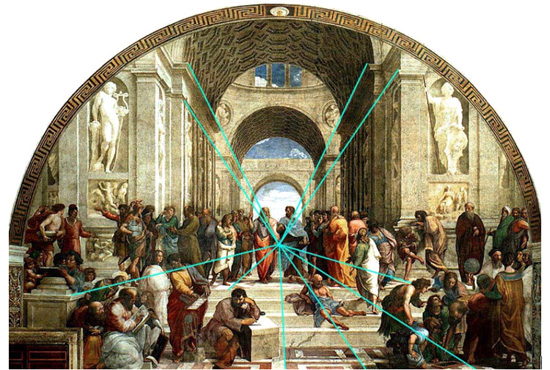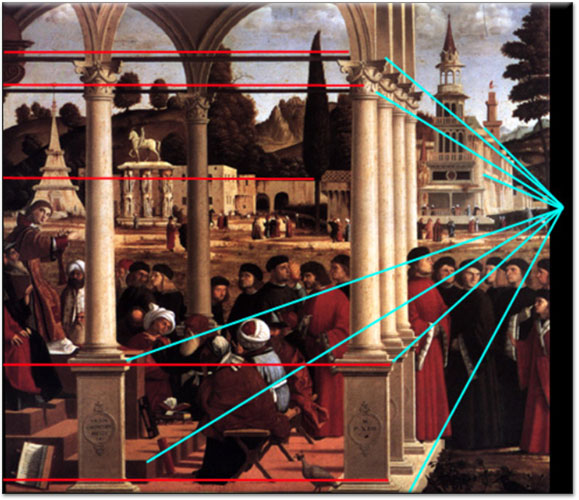|
The Role of Perspective in Shaping the Renaissance
 |
| Fig. 6. Three early Renaissance paintings
employing pronounced central perspective. Left: ‘Herod’s
Feast’ by Masolino (1436); center: ‘The Annunciation’,
by Fra Carnevale (1448); right: ‘The Flagellation of Christ’
by Piero della Francesca (1453). |
 |
It is surprising, in light of the enthusiasm for perspective depth representation
in this period, to find that almost all Renaissance examples relied on the
simple one-point perspective scheme. The characteristic of this scheme is
that verticals and one set of horizontals (the tranversals) are parallel to
the picture plane, so they exhibit no convergence and remain at right angle
to each other. Only the third set of horizontals recede into the distance,
and hence to a single vanishing point. Artists of the 15th and 16th centuries
almost never broke away from the concept of a principal vanishing point governing
a rectangular grid on which the architectural elements were constructed. Three
examples from the middle of the 15th century using a central vanishing point
are shown in Fig. 6. The Piero della Francesca, in particular, has been extensively
analyzed for the correctness of its perspective (Wittkower & Carter, 1953),
and for the highly accurate detail of the extreme foreshortening in the pavement
design, in particular.
 |
| Fig. 7. ‘The School of Athens’
by Raphael (1505), a fine example of architectural perspective with
a central vanishing point, marking the high point of the classical Renaissance. |
 |
One of the prime exponents of one-point perspective was Raphael, whose ‘School
of Athens’ fully displays the architectural grandeur that could be achieved
with this method, as a background for his evocation of the pantheon of ancient
Greek philosophers (Fig. 7). The central vanishing point is at Socrates left
hand, close to the eye height of the standing figures in front of the steps,
and just where it should be if the viewer was standing with them on the lower
floor. Raphael, the master draftsman, has fully employed the power of perspective
and its integration into a central vanishing point. He is also one of the few
artists before the 17th century to understand the logic of oblique perspective.
The drafting table in the center foreground is set at an oblique angle but converges
to a correct set of off-angle vanishing points in both directions. (To be correct,
they need to be at the same height as the central vanishing point.) The slight
awkwardness in the appearance of this drafting table seems to arise from the
oblique shadow at its base, which is hard to distinguish from the true line
of the base in the reproduction.
Throughout this period, artists had toyed with the location of the ‘central’
vanishing point, seemingly unaware that it should be directly in front of
the viewer’s eye for the painting to be in correct perspective. (The
optimal location is presumably centered laterally in the canvas, at a height
appropriate for a typical viewer). In any other position, the perspective
projection would be distorted and the depth impression either reduced or skewed.
An extreme case of such an offset is Carpaccio’s ‘Disputation
of St Stephen’ (Fig. 8), where the vanishing point is actually outside
the canvas to the right. Of course, the painter may choose to angle the structures
in the scene at any desired slant, so there is no inherent problem with having
a vanishing point near one side of the canvas. The problem is that, if this
choice is made, a second vanishing point is required for lines (horizontally)
at right angles to the first set. This requirement assumes that the viewer
does not also move over to the right to be in front of the displaced vanishing
point. (If one tries to do so before a full-sized version of such a picture,
the displaced viewing position feels quite unnatural.) The introduction of
a second vanishing point is the oblique, or two-point, perspective construction
of which virtually no examples can be found until the seventeenth century.
 |
| Fig. 8. ‘The Disputation of
St Stephen’ by Carpaccio (1514). This composition has a single
vanishing point beyond the right edge of the canvas. Lines orthogonal
to these receding lines are shown parallel to the canvas, with no second
vanishing point, giving the building the look of a parallelogram. This
construction would have to be viewed from directly in front of the vanishing
point for the perspective to be visually correct. |
 |
It seems that the one-point construction was the only accepted approach to
perspective for the first two centuries of the Renaissance. In fact, Andrea
Pozzo, the master of the illusionistic ceiling, wrote at the end of the 17th
century "By this [figure] you will see the Squares and Circles in Horizontal
Perspective always retain the Figures, without Alteration, save that of being
gradually diminish'd and made less: notwithstanding what some Painters have
taught and practised to the contrary." Here he is implicitly denying
the required convergence in the cross sections of square and circular columns
to a second vanishing point, and hence the need for two-point perspective.
He may have had in mind the case of central perspective, for which it is correct
to “retain the Figures”, i.e., depict the cross-sectional shape
without any distortion. But his reference to other painters implies that he
thinks they are incorrect to recommend distortions. The most likely interpretation
of those teachings is that they referred to two-point perspective, which had
become popular nearly 50 years before Pozzo was writing (Kemp, 1990).
< Previous Next > |
